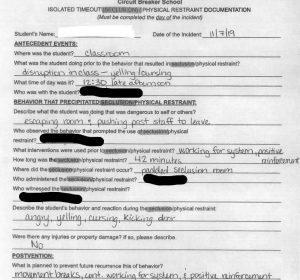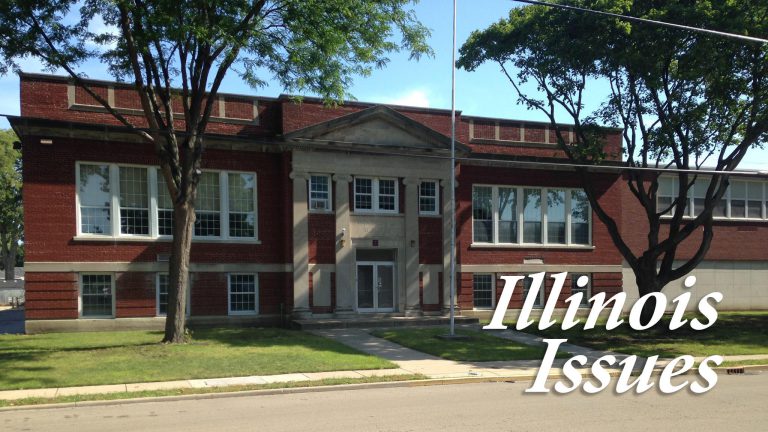Documents illustrate what happens when a student is put in an isolation room.
Peter Medlin reports for Illinois Issues.
It’s a few minutes before 10 a.m. and a student at Circuit Breaker School in Peru, Illinois is trying to escape the classroom. The child hits and kicks the glass window on the door, and doesn’t respond well to redirection and choices offered by staff. So staff takes the student to the timeout room, where the child screams and hits their head against the floor for two minutes.
The next day, another student is secluded for disrupting class and attempting to push past staff to escape. This student curses and kicks the timeout room door for 42 minutes. These accounts, written by school staff, were obtained by WNIJ under the Freedom of Information Act. Administrators from Circuit Breaker School did not respond to interview requests.

The use of seclusion or isolated timeouts in Illinois schools was thrust into the spotlight late last year by an investigation from ProPublica and the Chicago Tribune.
Laurie Heston is the director of special education at the Bi-County Special Education Cooperative.
“Those rooms aren’t viewed as punishment,” said Heston. “They’re more along the lines of rooms that are kind of stripped of anything that can hurt you and are a place you can safely get that energy out.” Heston also oversees Thome School in Rock Falls, Illinois. It has two padded timeout rooms, but she says they don’t seclude or use the rooms for punishment.Like Circuit Breaker, it’s a K-12 public school serving students with emotional challenges.
Circuit Breaker also has students with other health impairments and developmental delays, according to its website. If not seclusion, what are the rooms used for?
Heston says for younger students: “Those are the guys that usually just need to go in the room and they need to be allowed to kick the wall. They need to be allowed to scream, do whatever they need to do to get that energy out of them. My high school kids typically want to go into the timeout room because they want to get away from everyone,” she said.

She says a staff member typically sits in the doorway unless a student gets aggressive. Then they may close the door and look in through a window. “You can’t put a child into a padded closet involuntarily and it not be a punitive action,” said Kyle Hillman, director of legislative affairs with the National Association of Social Workers. “Whether the person is outside the door, whether the door is locked, whether the person is standing inside ignoring the child: that is not a therapeutic interaction.”
He also spoke out against seclusion at a recent legislative hearing. “You may get that kid to stop yelling, but you’re doing it in a punitive way that is creating trauma for that child,” said Hillman.
Seclusion is supposed to be used only when the student poses a safety threat to themselves or others. But the investigation documented thousands of instances where students were illegally secluded, where there was no safety concern.
In response to that report, Gov. J.B. Pritzker temporarily banned seclusion. Identical bills in both chambers of the Illinois legislature aim to permanently outlaw the practice. State officials are now investigating seven school districts alleged to have misused seclusion and restraint.
The emergency action also briefly banned some forms of restraint used on students. They did not halt use of sensory rooms, which, unlike seclusion rooms, often have bean bag chairs or headphones for students to unwind. Hillman says those kinds of rooms are beneficial.
State Senator Jennifer Bertino-Tarrant is chair of the Senate Education Committee. The Shorewood Democrat was an educator herself for nearly 20 years. “I have seen maybe more violent outbursts and it can be a very scary for people around that, especially when some of these kids are larger than the teachers. And so it’s very, very delicate,” said Bertino-Tarrant.
She says she’s heard from concerned parents, and some who understand why it happens for safety reasons in certain cases. “How effective these types of situations are is directly tied to how educators handle the situation,” she said.
That means educators need to be correctly trained. And there should be more state oversight. The emergency rule changes banning seclusion mandate districts send those seclusion documents to the State Board of Education.
Kyle Hillman agrees there needs to be more oversight, but says proper mental health professional staffing is even more crucial. According to the most recent federal data from 2013-14, Illinois secluded more than any other state.
 Jeff Keicher, a Republican state representative from Sycamore, says the incidents highlighted in the initial investigation were horrific. “We have to be vigilant; we have to be searching for where these bad actors are and we have to stop those practices. But we don’t need to throw the baby out with the bathwater, so to speak,” he said.
Jeff Keicher, a Republican state representative from Sycamore, says the incidents highlighted in the initial investigation were horrific. “We have to be vigilant; we have to be searching for where these bad actors are and we have to stop those practices. But we don’t need to throw the baby out with the bathwater, so to speak,” he said.
For now, seclusion is still banned under the state’s emergency action. But whether isolation in Illinois schools permanently ends is up to lawmakers this spring.
9(MDM5MjE5NTg1MDE1Mjk1MTM5NjlkMzI1ZQ000))

